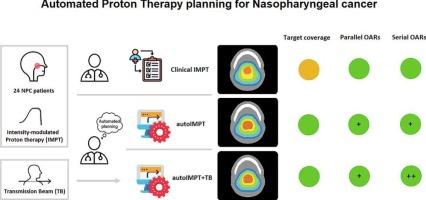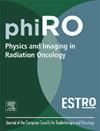全自动调强质子治疗鼻咽癌有或无传输光束的有效性验证
IF 3.3
Q2 ONCOLOGY
引用次数: 0
摘要
背景与目的:调强质子治疗(IMPT)在鼻咽癌(NPC)治疗中具有剂量/体积优势,但其过程复杂、耗时长,且bragg峰的宽侧半影可能影响关键结构附近的靶标覆盖。传输质子束(TBs)可以缓解这一问题,而全自动规划可以在减少规划时间的同时确保高质量的规划。本研究旨在评估TBs在NPC健全的全自动IMPT (autoIMPT)计划中的附加价值,并将其与手动生成的临床IMPT计划进行比较。材料与方法选取24例鼻咽癌患者,原发肿瘤接受70.00 Gy(RBE),择期体积接受54.25 Gy(RBE)。AutoIMPT-和AutoIMPT +TB计划由Erasmus-iCycle生成,使用相同的6束配置和临床约束。以剂量/体积为基础与临床计划进行了靶覆盖率、OAR剂量和正常组织并发症概率(NTCP)的比较。结果与临床计划相比,98%的自动化计划的体素(vw)最小目标(d98)相似或改善,特别是在目标覆盖率受损的情况下。在连续的OARs中,观察到明显的剂量减少,特别是在脑干和光学系统。在autoIMPT+TB计划中,连续OARs的剂量减少更为明显,对于vw-maximum视神经D0.03cm3,剂量减少可达22.5 Gy。同样,在大多数平行桨叶中观察到剂量减少(垂体Dmean - 13.2 Gy)。吞咽困难的NTCP保持不变;在自动化方案中,NTCP显著降低。结论:与临床计划相比,全自动IMPT和IMPT+TB计划实现了相似或更好的稳健目标覆盖和OAR节约。将结核病纳入IMPT在一系列OARs中显示出类似的目标覆盖范围和增强的剂量减少。本文章由计算机程序翻译,如有差异,请以英文原文为准。

Validation of fully automated intensity-modulated proton therapy with and without transmission beams for nasopharyngeal cancer
Background and purpose
Intensity-modulated proton therapy (IMPT) offers dose/volume advantages for nasopharyngeal cancer (NPC), however is complex, time-consuming, and the Bragg-peak’s broad lateral penumbra can compromise target coverage near critical structures. Transmission proton beams (TBs) may mitigate this, while fully automated planning can ensure high-quality plans with reduced planning times. This study aimed to evaluate the added value of TBs in robust, fully automated IMPT (autoIMPT) planning for NPC, and benchmarking these against manually generated clinical IMPT plans.
Materials and Methods
Twenty-four NPC patients previously treated with IMPT with 70.00 Gy(RBE) to the primary tumor and 54.25 Gy(RBE) to the elective volumes were included. AutoIMPT- and autoIMPT+TB plans were generated by Erasmus-iCycle, using the same 6-beam configuration and clinical constraints. Dose/volume-based comparison to clinical plans was performed for target coverage, OAR doses, and normal tissue complication probabilities (NTCP).
Results
Voxel-wise (vw) minimum target D98% of automated plans was similar or improved compared to clinical plans, especially in cases with compromised target coverage. In serial OARs, significant dose reductions were observed, especially in brainstem and optical system. Dose reductions to serial OARs were more pronounced in the autoIMPT+TB plans, up to 22.5 Gy for vw-maximum optical nerve D0.03cm3. Similarly, dose reductions in most parallel OARs were observed (−13.2 Gy in pituitary Dmean). NTCP for dysphagia remained equal; xerostomia NTCP was significantly lower in the automated plans.
Conclusions
Fully automated IMPT and IMPT+TB plans achieved similar or improved robust target coverage and OAR sparing compared to clinical plans. Incorporation of TBs to IMPT showed similar target coverage and enhanced dose reductions in serial OARs.
求助全文
通过发布文献求助,成功后即可免费获取论文全文。
去求助
来源期刊

Physics and Imaging in Radiation Oncology
Physics and Astronomy-Radiation
CiteScore
5.30
自引率
18.90%
发文量
93
审稿时长
6 weeks
 求助内容:
求助内容: 应助结果提醒方式:
应助结果提醒方式:


